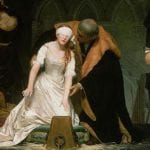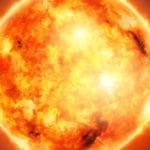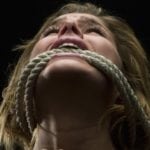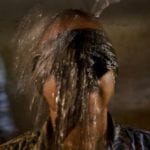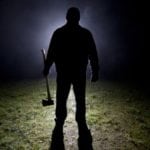 Animals
Animals  Animals
Animals  Weird Stuff
Weird Stuff 10 Weird Things People Used to Do at New Year’s
 Our World
Our World 10 Archaeological Discoveries of 2025 That Refined History
 Weird Stuff
Weird Stuff 10 Fascinating Facts You Might Not Know About Snow
 Miscellaneous
Miscellaneous Top 10 Things Crypto Was Supposed to Change & What Actually Did
 History
History 10 Huge Historical Events That Happened on Christmas Eve
 Music
Music 10 Surprising Origin Stories of Your Favorite Holiday Songs
 History
History 10 Less Than Jolly Events That Occurred on December 25
 Weird Stuff
Weird Stuff 10 Funny Ways That Researchers Overthink Christmas
 Politics
Politics 10 Political Scandals That Sent Crowds Into the Streets
 Animals
Animals 10 Species That Refused to Go Extinct
 Weird Stuff
Weird Stuff 10 Weird Things People Used to Do at New Year’s
 Our World
Our World 10 Archaeological Discoveries of 2025 That Refined History
Who's Behind Listverse?

Jamie Frater
Head Editor
Jamie founded Listverse due to an insatiable desire to share fascinating, obscure, and bizarre facts. He has been a guest speaker on numerous national radio and television stations and is a five time published author.
More About Us Weird Stuff
Weird Stuff 10 Fascinating Facts You Might Not Know About Snow
 Miscellaneous
Miscellaneous Top 10 Things Crypto Was Supposed to Change & What Actually Did
 History
History 10 Huge Historical Events That Happened on Christmas Eve
 Music
Music 10 Surprising Origin Stories of Your Favorite Holiday Songs
 History
History 10 Less Than Jolly Events That Occurred on December 25
 Weird Stuff
Weird Stuff 10 Funny Ways That Researchers Overthink Christmas
 Politics
Politics 10 Political Scandals That Sent Crowds Into the Streets
10 Terrifying Rulers Of The Underworld
Religions have had different ways of handling the afterlife. Some teach believers to embrace it as a victory. Others paint a picture so terrible that the devout spend their entire lives bribing the gods just to make it tolerable. The rulers of the underworld, likewise, have worn many faces.
10Hel

Hel is a Norse goddess who rules over a portion of the underworld. She was not born a goddess of the afterlife, though. The title was forced upon her when Odin cast her below the roots of the World Tree to rule over Niflheim—a cold, dark world of the dead—to thwart Ragnarok, the end of the world.
The three goddesses of fate had prophesied that the children of Loki, Hel and her siblings, would cause the death of the Norse pantheon’s leaders. To spare himself that fate, Odin hurled them to the far corners of the world.
Hel’s underworld was reserved for the souls of those who died of sickness, corruption, and old age. While the souls of the valiant dead feasted in Valhalla, Hel, not to be outdone, provided her own course. Her table was Hunger; her knife was Starvation. Her bed was Sickness, and the surrounding curtains were Misfortune. Hel herself struck a grisly figure. She was sinister, with half of her body appearing like a rotting corpse.
Though Odin cast her down into the underworld, Hel got her revenge when his son, Balder, died of poison. Despite the All-father’s pleas to ransom him, Hel refused to relinquish his soul. Since her power over her realm is absolute, Odin’s beloved son was doomed to spend eternity in her dreary abode.
9Yama

Yama is the king of hell in Hinduism, Buddhism, and Shinto. In Hinduism, he was the first man. His sister, Yami, was the first woman. Legend says that he became the Lord of the Dead after Yami wanted to conceive a child with him. Yama refused, considering intercourse with his sister to be incest. He later died. But without children, he couldn’t continue the cycle of rebirth and was resigned to remain forever in the land of the dead as its ruler.
In Buddhism, he is ruthless and without mercy—the ultimate judge of the dead. Yama even sends souls to multiple levels of the eight hells. A soul may serve its time in one level only to be sucked down into a worse level to pay for a different sin. Still, Yama is without partiality and is ultimately fair. Despite his cruelty, he is considered a righteous judge. At times, though, he has been forced to release a handful of lucky souls. One had been given the ability to turn hell into a lotus pool, so Yama was forced to spare him to preserve the integrity of his realm.
In some texts, Yama himself is subject to eternal torments. One story has him being followed by a cauldron of molten copper. It is said that he is fastened down by one of his own men, his mouth opened with a hook, and the molten copper poured down his throat. Whether this torment was decreed by Yama unto himself is unclear, but it certainly shows the belief that even the king of hell is subject to karma.
8Mictlantecuhtli

Mictlantecuhtli was the evil lord of the Aztec underworld, Mictlan. It was called the “Place of the Fleshless.” He was depicted as a bloody skeleton with bones shoved into his ears, draped in a necklace of human eyes.
Mictlantecuhtli devoured the dead. Those who did not die heroes were sent to his abode to live as weasels and beetles, drinking pus and eating scabs. Since departed souls lived in constant fear of the death god’s appetite, their living relatives would make human sacrifices on their behalf. The souls of those sacrificed were thought to be consumed before those of the relatives, hopefully staving off the ravenous god’s hunger. Such sacrificial rituals may have even been cannibalistic, though evidence is not entirely clear.
Despite the fear that Mictlantecuhtli inspired, he was also worshiped as a healer and associated with childbirth. His skeletal form was sometimes depicted with an open liver. The liver was believed to be the organ where the soul resided, which was connected to Mictlan, where all life-force originated. Bones were considered a life-giving source of light and heat in Aztec mythology, and it was believed that Mictlantecuhtli suffered his skeletal form because he was sacrificing his own health for that of his worshipers.
7Erlik

Erlik was the counterpart to the devil in several Altaic creation myths. Though accounts differ, he is generally seen as playing a large part in the creation of both the world and mankind. In one tale, he is cast into the primordial waters of the heavens after offending the creator god. There, he is forced to draw out the world from its depths then receives dominion over those evil like himself.
After tempting the first woman—very much like the story of Eve—he is cast into the underworld to become the ruler of demons. The Altaic devil makes occasional visits to the surface world, where yet another version has him creating womankind.
In this version, Erlik was the first man. He was cast into the underworld after boasting that he could create life better than Ulgen, the creator. Later, at Ulgen’s insistence, the eighth man tried to make the first woman. He succeeded in creating her body but failed to give her life. When he left to get help from Ulgen to finish his project, Erlik appeared and played seven flute notes in her ear. The music gave her life but also seven tempers and many bad moods.
6Mot

Mot was the unloved Semitic god of death. He had no worshipers, leading some to speculate that the deity was likened to a force of nature.
He was the jaws of death. His underworld was a dark and muddy place linked to his gullet. It was said that his bottom lip touched Earth, while his top reached the heavens. He was depicted as having a voracious appetite, which he even once defended when another deity complained about it. Mot was so feared that the other gods were warned not to get to close to him, lest they be swallowed. It was a warning that not all took to heart.
Mot was believed to have come into conflict with Baal, god of rains and storms. Baal had been setting himself up as the supreme deity among the Semitic gods. His only fear, though, was Mot. Baal feared Mot to the point where he built his divine palace without windows to keep the rival deity out.
Texts about the story are damaged and often illegible, but it is clear that the two ended up battling despite Baal’s best efforts. Mot simply devoured him. Fortunately for Baal, his wife was a warrior goddess. After Baal was defeated. she attacked and slew Mot, ground his body into powder, and sowed it in the fields. Baal was reborn, but so was Mot. The two did battle once more, though Mot fled at the intervention of the sun god.
5Supay

Supay was the Incan god of the dead and ruler of the underworld. Because his domain was in the deep earth, he was also known as the god of minerals and was often the object of miners’ rituals. Despite the wealth Supay worship could supposedly bring, he demanded human sacrifices to populate his kingdom—specifically, children. It was said that he demanded 100 children sacrificed to him annually.
When Spanish missionaries arrived in the Incan kingdom, they likened Satan to Supay. This led to a bit of confusion among the natives, since the tradition was to plead that Supay not harm them instead of simply rejecting him. Further confounding the Spaniards was that they arrived calling themselves “children of god.” They had meant it in the sense that they were Christians, but the Incas took it literally. Later, though, after the Incas realized the Spaniards’ true character, they began calling their unwanted guests the children of Supay.
4Ereshkigal

Ereshkigal was the Mesopotamian goddess of the underworld. There was no judgment or punishment under her rule, only equality. All souls under her dominion were equals, even other gods.
The way to her underworld was called the Road of No Return. On it, departed souls would pass through seven gates where they would be stripped of their possessions, even their clothes, entering Ereshkigal’s realm with absolutely nothing. It was a dark and dreary world where the shades of the dead sucked on clay and dust.
She was a vengeful goddess. At one point, she threatened to raise every soul under her thumb into the realm of the living—an army of the dead.
All the gods had been invited to a feast by their king. He could not travel to her abode, nor she to his, so a compromise was reached. Her portion of the feast would be taken to her by one of the goddess’s messengers. When he arrived, Nergal, the god of disease, failed to rise to greet him.
Ereshkigal was furious and demanded that Nergal come to her realm so she could kill him. When he came, she offered him a series of poisonous gifts, but Nergal refused them on the advice of his father and escaped. Even angrier now that she had failed, Ereshkigal demanded that he be returned to her lest she raise her undead army.
Nergal returned, but he came accompanied by a host of demons. He overpowered the goddess, who then offered him her hand in marriage if he would spare her life. He accepted, and the couple thenceforth ruled the underworld together.
3Batara Kala
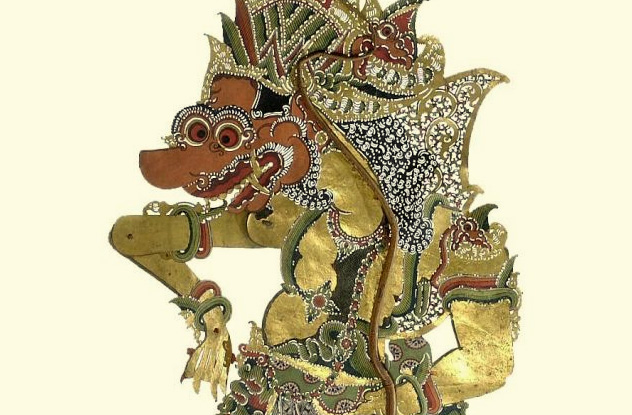
Batara Kala is a Javanese demon god who rules the underworld with his wife Setesuyara. Kala was born when creator god Batara Guru’s chief consort rejected his sexual advances while flying through the heavens. Poorly timed, his semen spilled into the ocean and was eaten by a fish, which gave birth to the god of the underworld.
HIs consort, Uma, was later banished to the world, where she raised the ogre-like Batara Kala. Kala had an enormous appetite, which his father took pity on by permitting him to eat any inedible object on Earth. During this divine taste-testing, though, Kala sampled human flesh. Developing a taste for it, Batara Guru allowed his son to eat certain kinds of humans.
Among the kind Kala is permitted to eat are children without siblings, children who have two siblings of the opposite sex, and people who break certain social codes. Ceremonies are carried out on children to stave off the voracious god of the underworld.
2Susanoo

In some of the earliest Shinto texts, Susanoo is the god of the underworld. He was banished from heaven after offending both the creator god and his sister, the sun goddess. He descended to the underworld after a period of adventuring on Earth. He then became its master.
Susanoo was a cruel god, especially to his own family. Legend says that his son, Okuninushi, descended to the underworld to marry his half-sister. There, Susanoo put him through all sorts of torturous trials. He threw him into a pit of snakes then locked him in a room full of wasps. When Okuninushi survived with the aid of his wife, his father shot an arrow into a moor and told him to retrieve it. Once he was inside, Susanoo set fire to it. Okuninushi again survived with the help of an underworld mouse and finally escaped by tying his father’s hair to the rafters as he slept.
Since Susanoo and his progeny were the patrons of the Izumo clan, a rival to the ruling family, many tales about him were ancient political propaganda. The sacred texts of the Shinto creation myths were compiled by the ruling family, who legend says were the divine descendants of the sun goddess.
Susanoo, while powerful, is always portrayed as subordinate to his sister. His son’s image suffers as well. Charged with taming the land, he fails in his duty and ultimately gives his reign over to the more capable descendants of the sun goddess, whom she had sent to bring order to the world.
1Hades

Though modern links to Satan have painted a negative picture of Hades, he was not particularly malevolent. Though men feared to speak his name for fear of death, he was also called a good god for sending his wealth upward into the realm of the living. His Roman name, Pluto, came from his Greek title, Plouton, meaning “Lord of Riches.”
Hades’s dominion was the underworld, but he also held power over the spoils of the earth, including precious metals and life-giving soil. He was sometimes depicted as a regal figure pouring forth wealth from the cornucopia.
The fact that Hades’s realm is the underworld is nothing more than bad luck. Along with his brothers, Hades defeated their evil father, Kronos. With the world now without a ruler, the siblings drew lots to decide who would have dominion over its various realms. Hades drew the worst lot, the underworld.
Even his famed abduction of Persephone was carried out because Zeus had betrothed her to him. Zeus had done so without her mother, Demeter’s, permission. Knowing she would object, Hades thought it best to forcefully take the daughter. He and Persephone then ruled the underworld together, at times even moved by compassion to release souls from his grasp.
The musician Orpheus, longing for the return of his beloved after she was poisoned by a snake, journeyed to the underworld and asked them to return her to life. They were so moved by his pleas that they allowed him to take his love back to the world. The only condition was that he could not look back at her until they were free of Hades’s domain. Orpheus failed at resurrecting his beloved when his concern for her well-being overcame his good sense, and he turned to check on her.
Nathan keeps a Japan blog where he writes about the sights, expat life, and finds Japanese culture in everyday items. You can also find him on Facebook and Twitter.
